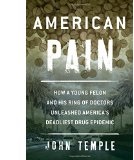
Two tattooed muscle head dudes in their twenties, one a convicted felon, who used to work construction as well as sell steroids, started a small business in which they hired a doctor to write prescriptions for pain medicine to most anyone who came through the clinic’s doors during business hours. The doctors got $75 a prescription, and were encouraged to see as many patients as possible, and $1000 a week for the use of their DEA MD number to order the pills. In no time, the clinic’s waiting room and parking lot was overflowing. Within two years the Florida business, officially named “American Pain,” was bringing in $40 million a year, 1000 other pain clinics had opened in the state and places like Kentucky and West Virginia* as well as other Eastern states were besieged by a public health and crime crisis of addicted citizens bent on their next fix. Two years after its doors opened American Pain, as the largest pill mill in Florida, was shut down by the DEA and the young entrepreneurs were on their way to jail, along with a few of their doctors, who were charged with the deaths of patients who overdosed.
*Kentucky and West Virginia had already tightened down on opiate prescriptions so their citizens headed south in van loads to go to Florida where there were basically no restrictions.
American Pain is a fascinating read, but oddly at the end, I felt myself somewhat rooting for the tattooed young men and a couple of the doctors, despite their actions, to get leniency. I am more of system responsibility guy than an individual responsibility guy. I hold individuals highly responsible, but I also think systems should be held to an even higher standard. What rankled me in the end was like the financial crisis and housing collapse, none of the powerful people who made it happen and who richly profited (billions) from it, ended up going to jail, and it was the common man who suffered. The system let these knuckleheads run their business, complete with highway billboards advertising their wares, in plain sight because they were really no laws against what they were doing.
There was little state regulation of pain clinics and the clinic’s doctors were following the “pain is what the patient says it is” mantra. The clinic tried to comply with laws in their own shady way, requiring MRIs (they made money on referrals) and urine tests(clean urine was evidently so available you could buy it at areas flea markets), and occasionally refusing to prescribe to clients who showed up under the influence.
In the pill mill crisis, the real bad guys were the pharmaceutical companies who made billions on a drug OxyContin that they knew was addictive and knew was easily abused, and who hid that fact from doctors as they launched an aggressive marketing campaign to promote the drug, and surprisingly the DEA, who on one hand was trying to stop over prescribing and street diversions, but on the other was approving the manufacture of larger and larger quantities of OxyContin at the manufacture’s request. Can you say political influence? The book points out that earlier national epidemics involving the misuse of Quaaludes and amphetamines had ended largely because the DEA had cut supply. In the OxyContin epidemic, the DEA did the exact opposite, helping the pharmaceutical company, Purdue Pharma, flood the markets with a killer drug.
What was most amazing to me is all of this was allowed to happen in 2009-2010, despite the publication of the 2003 expose Pain Killer by New York Times writer, Barry Meier, who laid out almost the same scenario of drug company promotion, widespread prescription writing, addiction and crime, with the DEA largely going along for the ride by upping the drug limits.
The sad twist to the tale of Purdue Pharma’s billions, and the pill mill business owners and their doctors who wrote prescriptions for what they convinced themselves was legal, but perhaps morally unethical profit, is the crackdown on pain management through prescription opiates has both launched an unprecedented heroin epidemic (shut off from pills junkies have turned to cheaper and more available heroin) and made proper pain management through responsible physicians harder to get for people in legitimate pain.

